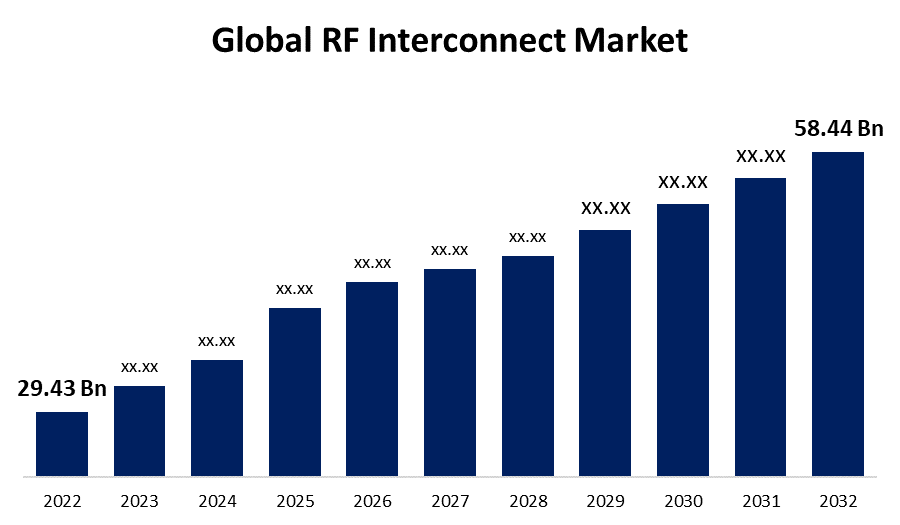Global RF Interconnect Market Size, Share, and COVID-19 Impact Analysis, By Type (RF Cable, RF Cable Assembly, RF Coaxial Adapter, and RF Connector), By Frequency (Up to 6 GHz, up to 50 GHz, and Above 50 GHz), By End-User (Aerospace & Defense, Medical, Industrial, and Others), By Region (North America, Europe, Asia-Pacific, Latin America, Middle East, and Africa), Analysis and Forecast 2022 – 2032.
Industry: Semiconductors & ElectronicsGlobal RF Interconnect Market Insights Forecasts to 2032
- The RF interconnect Market Size was valued at USD 29.43 Billion in 2022.
- The Market is Growing at a CAGR of 7.1% from 2022 to 2032.
- The Worldwide RF Interconnect Market is expected to reach USD 58.44 Billion by 2032.
- North America is expected to Grow the fastest during the forecast period.

Get more details on this report -
The global RF Interconnect Market Size is expected to reach USD 58.44 Billion by 2032, at a CAGR of 7.1% during the forecast period 2022 to 2032.
Market Overview
RF interconnect refers to the transmission of radio frequency signals between electronic devices or components. It is essential for the operation of wireless communication systems, such as cellular networks, Wi-Fi, and Bluetooth. RF interconnects are designed to minimize signal loss, interference, and noise, and are typically implemented using coaxial cables, microstrip lines, waveguides, or antennas. The selection of the appropriate interconnect technology depends on factors such as frequency range, power requirements, cost, and form factor. The design and optimization of RF interconnects are critical for achieving high performance and reliable wireless communication systems.
Report Coverage
This research report categorizes the market for RF interconnect market based on various segments and regions and forecasts revenue growth and analyzes trends in each submarket. The report analyses the key growth drivers, opportunities, and challenges influencing the RF interconnect market. Recent market developments and competitive strategies such as expansion, product launch, and development, partnership, merger, and acquisition have been included to draw the competitive landscape in the market. The report strategically identifies and profiles the key market players and analyses their core competencies in each sub-segments of the RF interconnect market.
Global RF Interconnect Market Report Coverage
| Report Coverage | Details |
|---|---|
| Base Year: | 2022 |
| Market Size in 2022: | USD 29.43 Billion |
| Forecast Period: | 2022-2032 |
| Forecast Period CAGR 2022-2032 : | 7.1% |
| 2032 Value Projection: | USD 58.44 Billion |
| Historical Data for: | 2019-2021 |
| No. of Pages: | 200 |
| Tables, Charts & Figures: | 120 |
| Segments covered: | By Type, By Frequency, By End-User, By Region. |
| Companies covered:: | Penn Engineering Components, Jupiter Microwave Components Inc., Quantic Electronics, Amphenol RF, Delta Electronics, Inc., Samtec, Cobham Advanced Electronic Solutions, Ducommun Incorporated, ETL Systems Ltd., Smiths Interconnect, DigiLens Inc., Corning Incorporated, Global Invacom, Radiall, HUBER + SUHNER, W.L. Gore & Associates, Inc., Flann Microwave Ltd. |
| Pitfalls & Challenges: | COVID-19 Empact, Challenge, Future, Growth, & Analysis |
Get more details on this report -
Driving Factors
The RF interconnect market is driven by several factors, including the increasing demand for wireless communication systems, the growing adoption of IoT devices, and the emergence of 5G networks. Other drivers include the need for high-speed data transfer and low-latency communication, the development of advanced interconnect technologies, and the rising demand for reliable and secure wireless communication solutions. The market is also influenced by factors such as technological advancements, government initiatives, and industry standards. Additionally, the increasing use of RF interconnects in various industries, such as automotive, aerospace, and healthcare, is expected to drive market growth in the coming years.
Restraining Factors
There are several factors that can restrain the growth of the RF interconnect market, including the high cost of advanced interconnect technologies, the complexity of designing and optimizing RF interconnects, and the increasing demand for miniaturization and low power consumption. Other restraints include the limited range and bandwidth of certain interconnect technologies, the lack of standardization, and the regulatory compliance requirements. Moreover, the COVID-19 pandemic has disrupted the global supply chain, leading to delays in production and shipment of interconnect components.
Market Segmentation
- In 2022, the RF cable segment accounted for around 34.5% market share
On the basis of type, the global RF interconnect market is segmented into RF cable, RF cable assembly, RF coaxial adapter, and RF connector. The RF cables segment is dominating with the largest market share in 2022, due to the widespread use of cables in various wireless communication systems, including cellular networks, satellite communications, and IoT devices. RF cable assemblies provide a reliable and cost-effective means of transmitting RF signals between components, and are available in various types, such as coaxial, twisted pair, and fiber optic cables. Moreover, the increasing demand for high-speed data transfer and low-latency communication has driven the adoption of advanced cable technologies, such as high-frequency coaxial cables, which further contributes to the growth of the segment.
- In 2022, the upto 50 GHz segment dominated with more than 39.7% market share
Based on frequency, the global RF interconnect market is segmented into up to 6 GHz, up to 50 GHz, and above 50 GHz. Out of this, the upto 50 GHz is dominating the market with the largest market share in 2022, due to its wide range of applications in various industries, including telecommunications, aerospace, and defense. The segment includes RF interconnects that can operate at frequencies up to 50 GHz, providing a reliable and high-speed means of transmitting RF signals. These interconnects are widely used in high-frequency applications, such as 5G networks, satellite communications, and radar systems. Additionally, the increasing demand for miniaturization and low-power consumption has led to the development of advanced interconnect technologies, such as high-frequency coaxial connectors and microstrip transmission lines, which further contribute to the growth of the segment.
Regional Segment Analysis of the RF Interconnect Market
- North America (U.S., Canada, Mexico)
- Europe (Germany, France, U.K., Italy, Spain, Rest of Europe)
- Asia-Pacific (China, Japan, India, Rest of APAC)
- South America (Brazil and the Rest of South America)
- The Middle East and Africa (UAE, South Africa, Rest of MEA)
Asia-Pacific dominated the market with around 45.6% revenue share in 2022.

Get more details on this report -
Based on region, Asia Pacific dominated the RF interconnect market due to the increasing adoption of wireless communication systems and IoT devices in countries such as China, Japan, South Korea, and India. The region has a large population base and a growing demand for high-speed data transfer, which drives the need for advanced interconnect technologies. Additionally, the region is home to several leading interconnect manufacturers, such as TE Connectivity, Amphenol, and Molex, which provide a wide range of interconnect solutions for various industries. The increasing investments in 5G networks, smart cities, and Industry 4.0 initiatives are also expected to boost the growth of the RF interconnect market in the region.
Recent Developments
In June 2022, Quantic Electronics has announced that it has acquired Microwave Dynamics, a company that specializes in the design and manufacture of phase-locked and free-running amplifiers, oscillators, frequency multipliers, and frequency converters for defense, aerospace, and industrial markets. This acquisition has allowed Quantic Electronics to expand its portfolio of products and improve its offerings to customers.
Competitive Analysis:
The report offers the appropriate analysis of the key organizations/companies involved within the global RF interconnect market along with a comparative evaluation primarily based on their product offering, business overviews, geographic presence, enterprise strategies, segment market share, and SWOT analysis. The report also provides an elaborative analysis focusing on the current news and developments of the companies, which includes product development, innovations, joint ventures, partnerships, mergers & acquisitions, strategic alliances, and others. This allows for the evaluation of the overall competition within the market.
List of Companies:
- Penn Engineering Components
- Jupiter Microwave Components Inc.
- Quantic Electronics
- Amphenol RF
- Delta Electronics, Inc.
- Samtec
- Cobham Advanced Electronic Solutions
- Ducommun Incorporated
- ETL Systems Ltd.
- Smiths Interconnect
- DigiLens Inc.
- Corning Incorporated
- Global Invacom
- Radiall
- HUBER + SUHNER
- W.L. Gore & Associates, Inc.
- Flann Microwave Ltd.
Key Target Audience
- Market Players
- Investors
- End-Users
- Government Authorities
- Consulting and Research Firm
- Venture Capitalists
- Value-Added Resellers (VARs)
Market Segment
This study forecasts revenue at global, regional, and country levels from 2019 to 2032. Spherical Insights has segmented the global RF interconnect market based on the below-mentioned segments:
RF Interconnect Market, By Type
- RF Cable
- RF Cable Assembly
- RF Coaxial Adapter
- RF Connector
RF Interconnect Market, By Frequency
- Up to 6 GHz
- Up to 50 GHz
- Above 50 GHz
RF Interconnect Market, By End-User
- Aerospace & Defense
- Medical
- Industrial
- Others
RF Interconnect Market, Regional Analysis
- North America
- US
- Canada
- Mexico
- Europe
- Germany
- UK
- France
- Italy
- Spain
- Russia
- Rest of Europe
- Asia Pacific
- China
- Japan
- India
- South Korea
- Australia
- Rest of Asia Pacific
- South America
- Brazil
- Argentina
- Rest of South America
- Middle East & Africa
- UAE
- Saudi Arabia
- Qatar
- South Africa
- Rest of Middle East & Africa
Need help to buy this report?